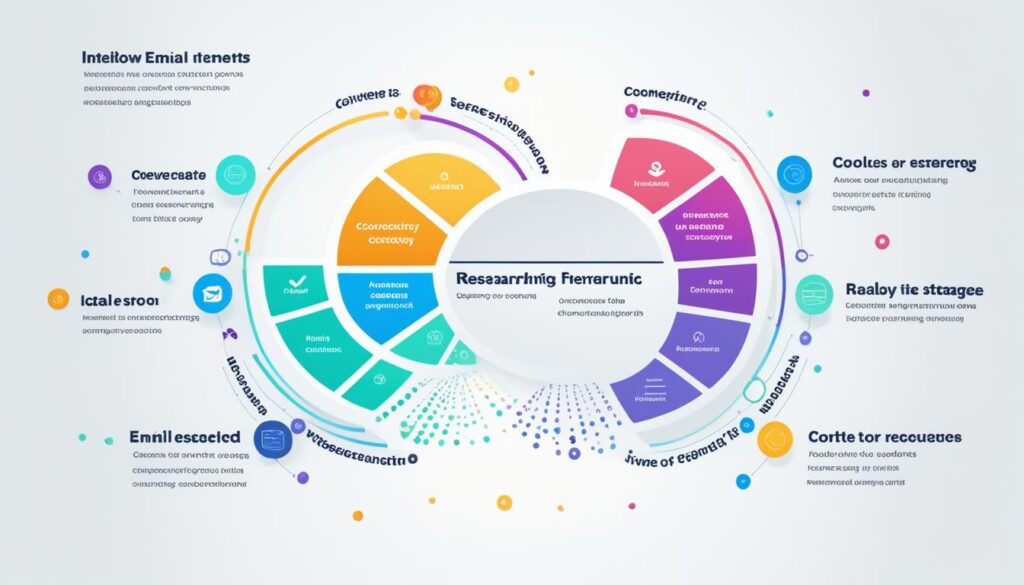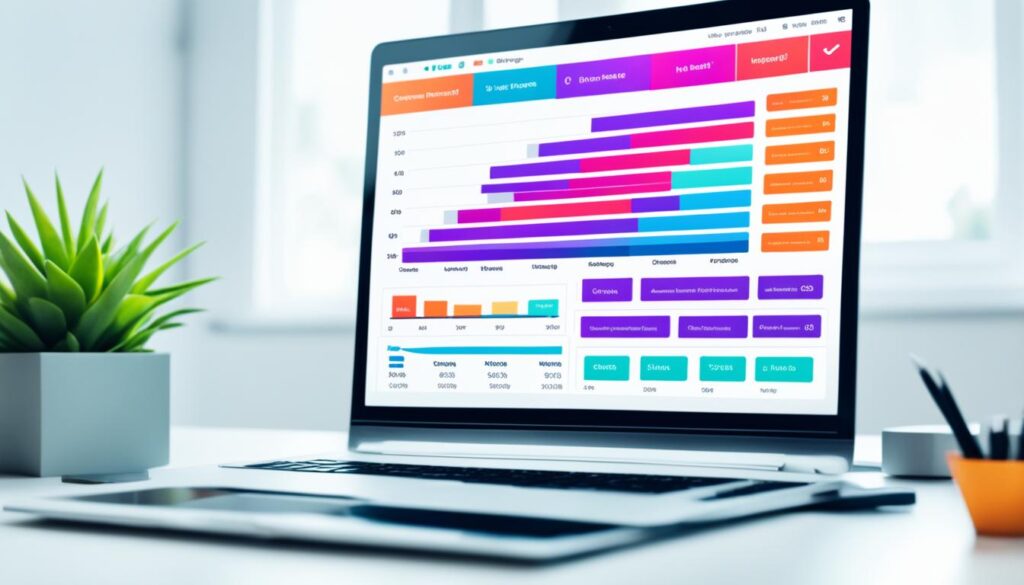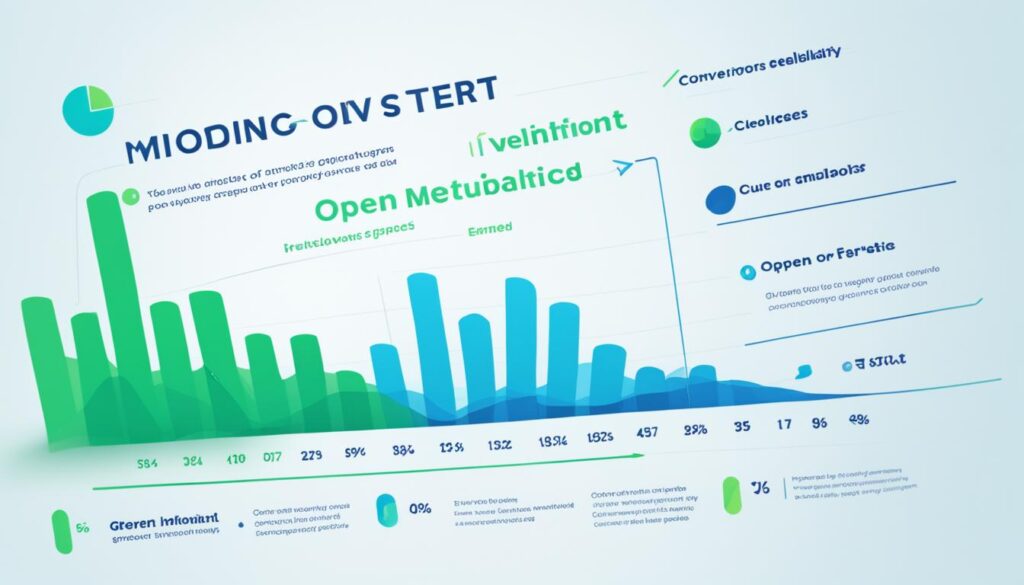Email marketing is a crucial component of any successful digital marketing strategy. To help you find the best email marketing tools for your needs, I have compiled a list of the top ten options available. These tools include email marketing software, top email marketing platforms, and email automation software. With these tools, you can create and manage effective email campaigns to drive engagement and conversion rates.
Use Tools Made for Email Marketing
When it comes to email marketing, it is important to use tools specifically designed for this purpose. Standard email services like Microsoft Outlook and Gmail are not optimized for email marketing campaigns. Instead, utilizing email marketing services and software will allow you to manage your contact list, generate leads, and track the success of your campaigns.
These tools offer a wide range of features to enhance your email marketing efforts. You can customize email templates, schedule automated campaigns, and segment your audience for more personalized messaging. Best of all, these tools can integrate with other marketing software, such as CRM platforms and landing page builders, to streamline your overall marketing strategy and drive better results.
Whether you are a small business launching your first email campaign or an experienced marketer looking to optimize your existing efforts, investing in the best email marketing software is essential. With the right tools at your disposal, you can create engaging and effective email campaigns that drive engagement, conversions, and ultimately, business growth.
Streamline Your Email Marketing Efforts
With the plethora of email marketing tools available, it can be challenging to find the best solution for your business. To help you in your search, I have curated a list of the top email marketing tools that offer the best features, functionality, and value for money. These tools have been selected based on their user-friendly interfaces, robust automation capabilities, and integration options.
| Email Marketing Tool | Key Features | Pricing |
|---|---|---|
| EmailTool | Intuitive drag-and-drop editor, advanced segmentation, A/B testing | $19/month |
| Mailchimp | Easy-to-use interface, marketing automation, detailed analytics | Free to $299/month |
| SendinBlue | Powerful automation workflows, SMS marketing, transactional emails | Free to $66/month |
| GetResponse | Responsive email design, webinar hosting, landing page builder | $15 to $99/month |
Above table showcases some of the best email marketing tools available, offering various features and pricing options to cater to different business needs. Depending on your budget, requirements, and level of technical expertise, you can find the perfect email marketing software that aligns with your goals and helps you achieve success.
By selecting the right email marketing tool, you can streamline your email marketing efforts, automate repetitive tasks, and deliver targeted messaging to your audience. Remember, the best email marketing software is the one that empowers you to create, analyze, and optimize your campaigns effectively.
Build Your Email List Proactively
Building an email list is a critical step in email marketing. In addition to collecting email addresses from customer interactions, it is important to actively grow your list.
One effective way to encourage leads to provide their email addresses is by offering valuable content or incentives. For example, you can create e-books related to your industry and offer them as a free download in exchange for an email address. This not only provides value to your audience but also helps you capture valuable contact information. Similarly, offering free trials or exclusive discounts through email signup can entice potential customers to share their email addresses with you.
By leveraging email templates and designing captivating email campaigns, you can maximize the impact of your email list. Email templates provide a professional and consistent look to your emails, making them visually appealing and increasing the chances of reader engagement.
| Email List Building Methods | Benefits |
|---|---|
| Offering valuable content or incentives | – Attract leads – Capture contact information – Build your email list |
| Promoting opt-in forms on your website | – Provide a convenient way for visitors to subscribe – Capture email addresses |
| Running contests or giveaways | – Generate buzz and excitement – Increase email signups |
| Using social media to drive signups | – Reach a wider audience – Direct traffic to your email signup form |
Another effective strategy is to promote your email signup offers on your website and through digital advertising. This can include creating prominent opt-in forms on your website’s homepage, blog posts, and landing pages. By optimizing your call-to-action buttons and providing compelling copy, you can encourage visitors to take action and subscribe to your email list.
As your email list grows, it becomes crucial to segment your audience. This allows you to create more targeted and personalized campaigns that resonate with your subscribers. By using audience segmentation, you can tailor your emails based on factors such as demographics, interests, or buying behavior. This personal touch enhances the relevance of your campaigns and increases engagement.
Segmentation Ideas:
- Demographic segmentation: Divide your audience based on age, gender, location, or occupation.
- Behavioral segmentation: Categorize subscribers based on their previous interactions with your emails or website.
- Preferences segmentation: Customize emails based on subscribers’ interests or preferences.
Remember, email list building is an ongoing process. Continuously seek opportunities to grow your list and engage your audience. By leveraging the power of email marketing tools, you can enhance your campaigns and drive meaningful results.

Building an engaged email list is a crucial aspect of successful email marketing. By proactively seeking new signups and employing effective segmentation strategies, you can create targeted email campaigns that resonate with your audience, driving increased open rates and conversions.
Segment Your List by User Intent
Segmenting your email list is a crucial strategy for effective email marketing. By dividing your audience based on user interests, purchase history, geographical location, or website interactions, you can create more personalized and relevant campaigns.
Segmentation allows you to tailor your emails to specific groups of subscribers, ensuring that your content resonates with their needs and preferences. Personalized emails have been proven to drive higher open rates, click-through rates, and conversions.
Why Segmenting Your List Matters
Segmentation enables you to send targeted emails that address your subscribers’ specific interests and needs. By understanding their preferences, you can provide content and offers that are highly relevant and valuable to them. This not only increases the chances of engagement but also strengthens your relationship with your subscribers.
Personalization is key in email marketing. It allows you to connect with your audience on a deeper level and build trust, ultimately leading to higher engagement and conversions.
Segmentation also helps you optimize your email marketing campaigns by allowing you to test different strategies and messages with specific segments of your audience. This enables you to gather valuable insights and make data-driven decisions to refine your email marketing strategy.
Automated Segmentation: Making it Easier
The best email marketing platforms offer automated segmentation features that streamline the process and save you time. These platforms use advanced algorithms and machine learning to analyze subscriber data and automatically segment your list.
For example, some platforms can segment your list based on demographics, purchase history, engagement levels, or any other criteria you define. This level of automation ensures that your subscribers receive targeted content without manual intervention.
Example of Segmentation Categories
Here is an example of how you can segment your email list based on different user intent categories:
| User Intent Category | Segment Description |
|---|---|
| Interest-based | Subscribers who have shown interest in specific products, services, or topics. |
| Geographical | Subscribers located in specific regions or cities relevant to your business. |
| Purchase history | Subscribers who have made purchases in the past, allowing you to tailor offers based on their buying behavior. |
| Engagement level | Segmenting subscribers based on their interaction with your emails, such as opens, clicks, or conversions. |
By segmenting your list, you can create highly targeted email marketing campaigns that resonate with your audience and drive better results. When subscribers receive content that is relevant to their needs, they are more likely to engage, convert, and become loyal customers.

Engage Your Readers at Every Step
Engaging your readers is crucial for the success of your email marketing campaigns. To ensure maximum impact, it’s essential to use the best email marketing tools for small businesses that offer email automation and provide a range of features to optimize your email campaigns.
Crafting compelling email content is just the first step. Beyond that, there are several tactics you can employ to increase open rates and click-through rates.
- Optimize your from and subject lines: The from name and subject line are the first things recipients see when they receive your email. Make sure they are attention-grabbing and relevant to entice readers to open your email.
- Keep your email body concise and informative: Avoid lengthy paragraphs and instead use short, easy-to-read sections. Use headings and bullet points to break up the content and make it scannable.
- Include clear call-to-action buttons or links: Your emails should have a clear purpose, and it should be easy for readers to take the desired action. Use visually appealing buttons or hyperlinked text to guide them.
Timing is another crucial factor in engaging your readers. Sending emails during optimal time windows can significantly impact engagement. Studies have shown that weekdays between 10 a.m. to 2 p.m. tend to generate the highest open rates and click-through rates. However, it’s important to test and analyze your specific audience’s behavior to determine the ideal sending times.
By mastering these tactics and utilizing the best email marketing tools for small businesses, you can create engaging and impactful email campaigns that drive results.
Example of Engaging Email Best Practices
“Optimizing the subject line and email body made a significant difference in our email engagement. We saw a 20% increase in open rates and a 15% increase in click-through rates by implementing these simple yet powerful tactics. Combined with the use of an email automation tool, we were able to streamline our campaigns and maximize engagement.” – Emily Brown, Marketing Manager

| Email Marketing Tools | Features | Price |
|---|---|---|
| Tool 1 | Email automation, A/B testing, analytics | $29/month |
| Tool 2 | Segmentation, personalization, landing page builder | $49/month |
| Tool 3 | Drag-and-drop email builder, CRM integration | $99/month |
Measure Your Email Marketing Campaign Results
To gauge the success of your email marketing campaigns, it is important to measure and analyze the results. Most email marketing software provides basic reports such as open rates, bounce rates, and click-through rates. By utilizing split testing or A/B testing, you can compare different variations of your email content to determine what works best. This data can then be used to refine your email marketing strategy and improve open and click rates.
When it comes to measuring email campaign performance, email analytics play a crucial role. By tracking key metrics, you can gain valuable insights into the effectiveness of your marketing efforts. Some of the important email analytics that you should consider monitoring include:
- Open rates: This metric shows the percentage of recipients who opened your email.
- Click-through rates: It indicates the percentage of recipients who clicked on links within your email.
- Bounce rates: This metric measures the percentage of emails that were undelivered or bounced back.
- Conversion rates: It tracks the percentage of recipients who took the desired action, such as making a purchase or filling out a form, after clicking a link in your email.
By analyzing these metrics, you can identify areas for improvement and optimize your email marketing campaigns for better results. For example, if your open rates are low, you may need to work on your subject lines or sender name to increase subscriber engagement. On the other hand, low click-through rates may indicate the need for more compelling email content or clearer call-to-action buttons.
Split testing, also known as A/B testing, is another valuable technique for measuring the effectiveness of your email marketing campaigns. It involves creating two or more variations of your email and sending them to different segments of your audience. By comparing the performance of each variation, you can identify the elements that resonate best with your subscribers and incorporate them into future campaigns.
Furthermore, tracking email conversions is essential for understanding the ROI of your email marketing efforts. By integrating your email marketing software with your website analytics or CRM platform, you can track the specific actions taken by recipients after clicking links in your emails. This data will enable you to measure the overall impact of your email campaigns on your marketing goals, such as generating leads, driving sales, or increasing website traffic.
In conclusion, measuring the results of your email marketing campaigns is crucial for optimizing your strategy and obtaining valuable insights into customer behavior. By leveraging the features and analytics provided by email marketing services, you can track key metrics, perform split testing, and analyze conversions to improve the performance of your email campaigns.

Key Email Marketing Analytics
| Metric | Description |
|---|---|
| Open Rate | The percentage of recipients who opened your email. |
| Click-through Rate | The percentage of recipients who clicked on links within your email. |
| Bounce Rate | The percentage of emails that were undelivered or bounced back. |
| Conversion Rate | The percentage of recipients who took the desired action after clicking a link in your email. |
Scrub, Rinse and Repeat
Maintaining a clean and engaged email list is essential for successful email marketing. By regularly scrubbing your list and removing bounced email addresses, you can improve deliverability rates and ensure that your emails land in the inbox rather than the spam folder. Most email marketing platforms offer built-in features to remove bounced email addresses easily, allowing you to continue with your campaigns.
However, a clean email list is just one piece of the puzzle. It’s also crucial to provide prompt customer support to address any issues or concerns related to your email marketing efforts. Whether it’s technical difficulties, questions about transactional emails, or general inquiries, offering excellent customer support can help you build trust and foster long-lasting relationships with your subscribers.
Why is Scrubbing Your Email List Important?
Scrubbing your email list refers to the process of regularly removing bounced email addresses, unsubscribed users, and inactive subscribers. Here are a few reasons why this practice is crucial:
- Improved Deliverability: By removing bounced email addresses, you can increase the chances of your emails reaching the intended recipients’ inboxes. This helps maintain a positive sender reputation and avoids getting marked as spam.
- Cost Optimization: Sending emails to inactive or non-existent addresses is a waste of resources. By scrubbing your list, you can focus your efforts on engaged subscribers who are more likely to interact with your emails and convert into customers.
- Enhanced Metrics and Analysis: A clean email list provides more accurate data and insights into your email marketing campaigns. It allows you to track open rates, click-through rates, and other metrics more effectively, enabling you to make data-driven decisions to optimize your future campaigns.
The Importance of Customer Support in Email Marketing
“Good customer service costs less than bad customer service.” – Sally Gronow, Email Marketing Expert
In addition to maintaining a clean email list, it’s essential to provide prompt and efficient customer support. Here’s why customer support matters in email marketing:
- User Satisfaction: When subscribers encounter issues or have questions about your email marketing efforts, responsive and helpful customer support can turn a potentially frustrating experience into a positive one. This fosters trust and loyalty among your subscribers.
- Issue Resolution: Promptly addressing technical difficulties or concerns related to transactional emails can help minimize disruptions in your email marketing campaigns. Efficient problem-solving can keep your campaigns running smoothly and ensure a seamless experience for your subscribers.
- Relationship Building: Providing excellent customer support demonstrates your commitment to your subscribers’ needs and satisfaction. It helps foster strong relationships, leading to increased engagement and potential conversions in the long run.
Remember, email marketing is not just about delivering compelling campaigns—it’s about connecting with your subscribers and building relationships. By focusing on maintaining a clean email list and offering exceptional customer support, you can maximize the effectiveness of your email marketing efforts.
Image:

| Benefits of Scrubbing Your Email List | Importance of Customer Support |
|---|---|
| Improved deliverability | User satisfaction |
| Cost optimization | Issue resolution |
| Enhanced metrics and analysis | Relationship building |
Salesforce Pardot – Best Overall Email Marketing Tool
When it comes to finding the best email marketing software, Salesforce Pardot tops the list. With its comprehensive features and advanced capabilities, Pardot provides everything you need to run effective email campaigns and drive engagement. Let’s take a closer look at what makes Salesforce Pardot the best overall email marketing tool.

| Features | Benefits |
|---|---|
| Powerful Automation | Save time and effort with automated email workflows and lead nurturing. |
| Integration with Salesforce Apps | Seamlessly connect your email marketing with your CRM and other Salesforce tools for a complete marketing solution. |
| AI-Based Decision-Making | Leverage artificial intelligence to make data-driven decisions for more effective email campaigns. |
| Advanced Reporting and Analytics | Gain insights into the performance of your email campaigns and make data-backed optimizations. |
| Market-Leading Support | Get access to excellent customer support and guidance to maximize the use of Salesforce Pardot. |
Why Choose Salesforce Pardot?
While Salesforce Pardot may come with a higher price tag compared to other email marketing tools, the investment is well worth it for midsize businesses and those with sufficient revenue. The powerful automation capabilities allow you to streamline your email marketing efforts, saving you valuable time and resources. Additionally, the integration with other Salesforce apps ensures a seamless experience for your marketing team, with all your tools working together harmoniously.
One standout feature of Salesforce Pardot is its AI-based decision-making tools. By leveraging artificial intelligence, you can make data-driven decisions and optimize your email campaigns for maximum effectiveness. The advanced reporting and analytics provide valuable insights into the performance of your emails, enabling you to continuously improve your strategies.
Furthermore, Salesforce Pardot provides market-leading support, ensuring that you have access to experts who can guide you through the platform and help you achieve your marketing goals. Their team of professionals is dedicated to assisting you in making the most of Salesforce Pardot and driving success with your email marketing campaigns.
In summary, Salesforce Pardot is the best overall email marketing tool due to its comprehensive features, advanced capabilities, and market-leading support. While it may require a higher investment, the benefits far outweigh the cost, making Salesforce Pardot the top choice for businesses looking for a robust and effective email marketing solution.
Campaigner – Best for Experienced Marketers
Campaigner is an email marketing tool that stands out for its customization options and competitive pricing. It offers a range of features, including a powerful workflow designer and integration with third-party software. While it may not have all the advanced features of some competitors, it is a reliable choice for experienced marketers and midsize or larger businesses. The productivity-focused UI and comprehensive online resources make it easy to create and manage effective email campaigns.
Key Features of Campaigner:
- Customizable email templates
- Advanced automation workflows
- Integration with popular CRM and e-commerce platforms
- In-depth reporting and analytics
- A/B testing for optimizing email campaigns
With Campaigner’s customizable email templates, you can create visually appealing and on-brand emails that resonate with your audience. The platform’s advanced automation workflows allow you to set up personalized customer journeys based on user behavior, increasing engagement and conversions. Additionally, Campaigner’s integration with popular CRM and e-commerce platforms ensures seamless data syncing and maximizes the efficiency of your marketing efforts.
Campaigner provides in-depth reporting and analytics, allowing you to track the performance of your email campaigns in real-time. By monitoring key metrics such as open rates, click-through rates, and conversions, you can gain valuable insights into your audience’s behavior and make data-driven decisions to optimize future campaigns.
A/B testing is another standout feature of Campaigner, enabling you to experiment with different email variations and determine which resonates best with your subscribers. This helps you refine your email content and design to maximize engagement and achieve higher conversion rates.
In conclusion, Campaigner is a reliable email marketing software that offers advanced customization options, competitive pricing, and a range of features to support experienced marketers in creating and managing successful email campaigns. With its intuitive UI and comprehensive online resources, Campaigner empowers marketers to drive engagement, conversions, and business growth.

HubSpot Marketing Hub – Best for Scalable Marketing Plans
HubSpot Marketing Hub is more than just an email marketing tool; it is a comprehensive marketing platform designed for scalability. With a focus on tracking and optimizing the entire customer journey, it offers a wide range of features for small to midsize businesses. While the pricing tiers can be confusing and the feature set can be overwhelming, businesses seeking a single solution that integrates CRM, email, and other marketing features will find value in HubSpot Marketing Hub.
Key Features of HubSpot Marketing Hub
- Marketing Automation: HubSpot Marketing Hub provides robust marketing automation capabilities, allowing you to streamline and personalize your marketing campaigns.
- CRM Integration: The platform seamlessly integrates with HubSpot CRM, providing a unified view of your contacts and enabling better targeting and segmentation.
- Email Marketing Software: HubSpot Marketing Hub offers a powerful email marketing software, allowing you to create and send engaging email campaigns.
- Analytics and Reporting: With built-in analytics and reporting tools, HubSpot Marketing Hub enables you to measure the performance of your email campaigns and gain valuable insights.
HubSpot Marketing Hub stands out for its scalability and its ability to support the growth of your marketing efforts. Whether you are a small business looking to expand or a midsize company aiming for more sophisticated marketing strategies, HubSpot Marketing Hub provides the tools and capabilities to meet your needs.
“HubSpot Marketing Hub is a game-changer for our business. It has helped us automate our email marketing campaigns and integrate them with our CRM seamlessly. The platform’s scalability makes it a valuable asset for our marketing team.”

| Pros | Cons |
|---|---|
| Comprehensive marketing platform | Pricing can be complex |
| Offers marketing automation capabilities | Feature set may be overwhelming for beginners |
| Integration with HubSpot CRM | Support documentation can be extensive |
| Powerful email marketing software | |
| Advanced analytics and reporting |
Conclusion
Email marketing is an integral part of any successful digital marketing strategy. It allows businesses to create and manage effective email campaigns that drive engagement and conversions. Whether you are a small business or a midsize enterprise, there is a wide range of email marketing tools available to suit different needs and budgets.
From email marketing software to top email marketing platforms, businesses have the opportunity to elevate their email marketing efforts. It’s crucial to consider your goals, budget, and desired features when choosing the best email marketing tool for your business. With the right tools in place, you can effectively connect with your audience and achieve your marketing objectives.
Remember that email marketing is not a one-size-fits-all approach. Every business is unique, so it’s essential to select the tool that aligns with your specific requirements. Whether you prioritize automation, customization, or seamless integration with other marketing software, there is a solution out there for you. Take the time to research and choose the best email marketing tool that will help you achieve your desired results.




